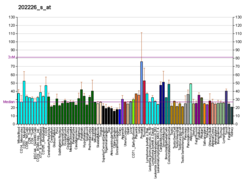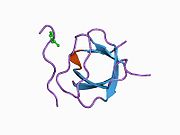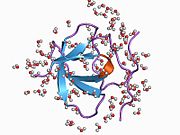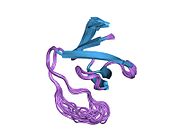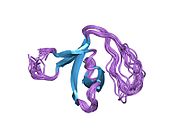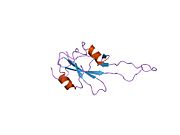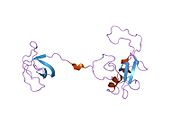Adapter molecule crk
Adapter molecule crk also known as proto-oncogene c-Crk is a protein that in humans is encoded by the CRK gene.[5]
The CRK protein participates in the Reelin signaling cascade downstream of DAB1.[6][7]
Function
[edit]Adapter molecule crk is a member of an adapter protein family that binds to several tyrosine-phosphorylated proteins. This protein has several SH2 and SH3 domains (src-homology domains) and is involved in several signaling pathways, recruiting cytoplasmic proteins in the vicinity of tyrosine kinase through SH2-phosphotyrosine interaction. The N-terminal SH2 domain of this protein functions as a positive regulator of transformation whereas the C-terminal SH3 domain functions as a negative regulator of transformation. Two alternative transcripts encoding different isoforms with distinct biological activity have been described.[8]
Crk together with CrkL participates in the Reelin signaling cascade downstream of DAB1.[6][7]
v-Crk, a transforming oncoprotein from avian sarcoma viruses, is a fusion of viral "gag" protein with the SH2 and SH3 domains of cellular Crk.[9] The name Crk is from "CT10 Regulator of Kinase" where CT10 is the avian virus from which was isolated a protein, lacking kinase domains, but capable of stimulating phosphorylation of tyrosines in cells.[10]
Crk should not be confused with Src, which also has cellular (c-Src) and viral (v-Src) forms and is involved in some of the same signaling pathways but is a protein tyrosine-kinase.
Interactions
[edit]CRK (gene) has been shown to interact with:
- BCAR1,[11][12][13][14][15][16][17][18][19][excessive citations]
- Cbl gene,[20][21]
- Dock180,[22][13][14][23][24]
- EPS15,[25]
- Epidermal growth factor receptor,[26][27]
- Grb2,[28][22][29]
- IRS4,[30][31]
- MAP4K1,[32][33][34]
- MAPK8,[35]
- NEDD9,[36][37]
- PDGFRA,[38][39]
- PDGFRB,[38]
- PTK2,[13][16]
- Paxillin[16][40]
- RAPGEF1,[41]
- RICS,[42][43]
- SH3KBP1,[44] and
- SOS1.[29]
See also
[edit]- CrkL, "Crk-like" protein
References
[edit]- ^ a b c GRCh38: Ensembl release 89: ENSG00000167193 – Ensembl, May 2017
- ^ a b c GRCm38: Ensembl release 89: ENSMUSG00000017776 – Ensembl, May 2017
- ^ "Human PubMed Reference:". National Center for Biotechnology Information, U.S. National Library of Medicine.
- ^ "Mouse PubMed Reference:". National Center for Biotechnology Information, U.S. National Library of Medicine.
- ^ Mayer BJ, Hanafusa H (1990). "Association of the v-crk oncogene product with phosphotyrosine-containing proteins and protein kinase activity". Proc Natl Acad Sci U S A. 87 (7): 2638–42. Bibcode:1990PNAS...87.2638M. doi:10.1073/pnas.87.7.2638. PMC 53745. PMID 1690891.
- ^ a b Matsuki T, Pramatarova A, Howell BW (June 2008). "Reduction of Crk and CrkL expression blocks reelin-induced dendritogenesis". J. Cell Sci. 121 (Pt 11): 1869–75. doi:10.1242/jcs.027334. PMC 2430739. PMID 18477607.
- ^ a b Park TJ, Curran T (December 2008). "Crk and Crk-like play essential overlapping roles downstream of disabled-1 in the Reelin pathway". J. Neurosci. 28 (50): 13551–62. doi:10.1523/JNEUROSCI.4323-08.2008. PMC 2628718. PMID 19074029.
- ^ "Entrez Gene: CRK v-crk sarcoma virus CT10 oncogene homolog (avian)".
- ^ Tetsuya Nakamoto, Ryuichi Sakai, Keiya Ozawa, Yoshio Yazaki, Hisamaru Hirai (1996). "Direct Binding of C-terminal Region of p130Graphic to SH2 and SH3 Domains of Src Kinase". J. Biol. Chem. 271 (15): 8959–8965. doi:10.1074/jbc.271.15.8959. PMID 8621540.
- ^ Mayer BJ, Hamaguchi M, Hanafusa H (March 1988). "A novel viral oncogene with structural similarity to phospholipase C". Nature. 332 (6161): 272–5. Bibcode:1988Natur.332..272M. doi:10.1038/332272a0. PMID 2450282. S2CID 4352676.
- ^ Zhou B, Liu L, Reddivari M, Zhang XA (2004). "The palmitoylation of metastasis suppressor KAI1/CD82 is important for its motility- and invasiveness-inhibitory activity". Cancer Res. 64 (20): 7455–63. doi:10.1158/0008-5472.CAN-04-1574. PMID 15492270.
- ^ Di Stefano P, Cabodi S, Boeri Erba E, Margaria V, Bergatto E, Giuffrida MG, Silengo L, Tarone G, Turco E, Defilippi P (2004). "P130Cas-associated protein (p140Cap) as a new tyrosine-phosphorylated protein involved in cell spreading". Mol. Biol. Cell. 15 (2): 787–800. doi:10.1091/mbc.E03-09-0689. PMC 329393. PMID 14657239.
- ^ a b c Hsia DA, Mitra SK, Hauck CR, Streblow DN, Nelson JA, Ilic D, Huang S, Li E, Nemerow GR, Leng J, Spencer KS, Cheresh DA, Schlaepfer DD (2003). "Differential regulation of cell motility and invasion by FAK". J. Cell Biol. 160 (5): 753–67. doi:10.1083/jcb.200212114. PMC 2173366. PMID 12615911.
- ^ a b Gu J, Sumida Y, Sanzen N, Sekiguchi K (2001). "Laminin-10/11 and fibronectin differentially regulate integrin-dependent Rho and Rac activation via p130(Cas)-CrkII-DOCK180 pathway". J. Biol. Chem. 276 (29): 27090–7. doi:10.1074/jbc.M102284200. PMID 11369773.
- ^ Garton AJ, Tonks NK (1999). "Regulation of fibroblast motility by the protein tyrosine phosphatase PTP-PEST". J. Biol. Chem. 274 (6): 3811–8. doi:10.1074/jbc.274.6.3811. PMID 9920935.
- ^ a b c Angers-Loustau A, Côté JF, Charest A, Dowbenko D, Spencer S, Lasky LA, Tremblay ML (1999). "Protein tyrosine phosphatase-PEST regulates focal adhesion disassembly, migration, and cytokinesis in fibroblasts". J. Cell Biol. 144 (5): 1019–31. doi:10.1083/jcb.144.5.1019. PMC 2148201. PMID 10085298.
- ^ Qiu W, Cobb RR, Scholz W (1998). "Inhibition of p130cas tyrosine phosphorylation by calyculin A". J. Leukoc. Biol. 63 (5): 631–5. doi:10.1002/jlb.63.5.631. PMID 9581808. S2CID 11177730.
- ^ Blaukat A, Ivankovic-Dikic I, Grönroos E, Dolfi F, Tokiwa G, Vuori K, Dikic I (1999). "Adaptor proteins Grb2 and Crk couple Pyk2 with activation of specific mitogen-activated protein kinase cascades". J. Biol. Chem. 274 (21): 14893–901. doi:10.1074/jbc.274.21.14893. PMID 10329689.
- ^ Wang JF, Park IW, Groopman JE (2000). "Stromal cell-derived factor-1alpha stimulates tyrosine phosphorylation of multiple focal adhesion proteins and induces migration of hematopoietic progenitor cells: roles of phosphoinositide-3 kinase and protein kinase C". Blood. 95 (8): 2505–13. doi:10.1182/blood.V95.8.2505. PMID 10753828.
- ^ Gesbert F, Garbay C, Bertoglio J (1998). "Interleukin-2 stimulation induces tyrosine phosphorylation of p120-Cbl and CrkL and formation of multimolecular signaling complexes in T lymphocytes and natural killer cells". J. Biol. Chem. 273 (7): 3986–93. doi:10.1074/jbc.273.7.3986. PMID 9461587.
- ^ Husson H, Mograbi B, Schmid-Antomarchi H, Fischer S, Rossi B (1997). "CSF-1 stimulation induces the formation of a multiprotein complex including CSF-1 receptor, c-Cbl, PI 3-kinase, Crk-II and Grb2". Oncogene. 14 (19): 2331–8. doi:10.1038/sj.onc.1201074. PMID 9178909.
- ^ a b Matsuda M, Ota S, Tanimura R, Nakamura H, Matuoka K, Takenawa T, Nagashima K, Kurata T (1996). "Interaction between the amino-terminal SH3 domain of CRK and its natural target proteins". J. Biol. Chem. 271 (24): 14468–72. doi:10.1074/jbc.271.24.14468. PMID 8662907.
- ^ Nishihara H, Kobayashi S, Hashimoto Y, Ohba F, Mochizuki N, Kurata T, Nagashima K, Matsuda M (1999). "Non-adherent cell-specific expression of DOCK2, a member of the human CDM-family proteins". Biochim. Biophys. Acta. 1452 (2): 179–87. doi:10.1016/S0167-4889(99)00133-0. PMID 10559471.
- ^ Hasegawa H, Kiyokawa E, Tanaka S, Nagashima K, Gotoh N, Shibuya M, Kurata T, Matsuda M (1996). "DOCK180, a major CRK-binding protein, alters cell morphology upon translocation to the cell membrane". Mol. Cell. Biol. 16 (4): 1770–6. doi:10.1128/MCB.16.4.1770. PMC 231163. PMID 8657152.
- ^ Schumacher C, Knudsen BS, Ohuchi T, Di Fiore PP, Glassman RH, Hanafusa H (1995). "The SH3 domain of Crk binds specifically to a conserved proline-rich motif in Eps15 and Eps15R". J. Biol. Chem. 270 (25): 15341–7. doi:10.1074/jbc.270.25.15341. PMID 7797522.
- ^ 9614078 Schulze WX, Deng L, Mann M (2005). "Phosphotyrosine interactome of the ErbB-receptor kinase family". Mol. Syst. Biol. 1 (1): E1 – E13. doi:10.1038/msb4100012. PMC 1681463. PMID 16729043.
- ^ Hashimoto Y, Katayama H, Kiyokawa E, Ota S, Kurata T, Gotoh N, Otsuka N, Shibata M, Matsuda M (1998). "Phosphorylation of CrkII adaptor protein at tyrosine 221 by epidermal growth factor receptor". J. Biol. Chem. 273 (27): 17186–91. doi:10.1074/jbc.273.27.17186. PMID 9642287.
- ^ Riordan SM, Lidder S, Williams R, Skouteris GG (2000). "The beta-subunit of the hepatocyte growth factor/scatter factor (HGF/SF) receptor phosphorylates and associates with CrkII: expression of CrkII enhances HGF/SF-induced mitogenesis". Biochem. J. 350 (3): 925–32. doi:10.1042/0264-6021:3500925. PMC 1221328. PMID 10970810.
- ^ a b Okada S, Pessin JE (1996). "Interactions between Src homology (SH) 2/SH3 adapter proteins and the guanylnucleotide exchange factor SOS are differentially regulated by insulin and epidermal growth factor". J. Biol. Chem. 271 (41): 25533–8. doi:10.1074/jbc.271.41.25533. PMID 8810325.
- ^ Karas M, Koval AP, Zick Y, LeRoith D (2001). "The insulin-like growth factor I receptor-induced interaction of insulin receptor substrate-4 and Crk-II". Endocrinology. 142 (5): 1835–40. doi:10.1210/endo.142.5.8135. PMID 11316748.
- ^ Koval AP, Karas M, Zick Y, LeRoith D (1998). "Interplay of the proto-oncogene proteins CrkL and CrkII in insulin-like growth factor-I receptor-mediated signal transduction". J. Biol. Chem. 273 (24): 14780–7. doi:10.1074/jbc.273.24.14780. PMID 9614078.
- ^ Oehrl W, Kardinal C, Ruf S, Adermann K, Groffen J, Feng GS, Blenis J, Tan TH, Feller SM (1998). "The germinal center kinase (GCK)-related protein kinases HPK1 and KHS are candidates for highly selective signal transducers of Crk family adapter proteins". Oncogene. 17 (15): 1893–901. doi:10.1038/sj.onc.1202108. PMID 9788432.
- ^ Ling P, Yao Z, Meyer CF, Wang XS, Oehrl W, Feller SM, Tan TH (1999). "Interaction of hematopoietic progenitor kinase 1 with adapter proteins Crk and CrkL leads to synergistic activation of c-Jun N-terminal kinase". Mol. Cell. Biol. 19 (2): 1359–68. doi:10.1128/MCB.19.2.1359. PMC 116064. PMID 9891069.
- ^ Ling P, Meyer CF, Redmond LP, Shui JW, Davis B, Rich RR, Hu MC, Wange RL, Tan TH (2001). "Involvement of hematopoietic progenitor kinase 1 in T cell receptor signaling". J. Biol. Chem. 276 (22): 18908–14. doi:10.1074/jbc.M101485200. PMID 11279207.
- ^ Girardin SE, Yaniv M (2001). "A direct interaction between JNK1 and CrkII is critical for Rac1-induced JNK activation". EMBO J. 20 (13): 3437–46. doi:10.1093/emboj/20.13.3437. PMC 125507. PMID 11432831.
- ^ Minegishi M, Tachibana K, Sato T, Iwata S, Nojima Y, Morimoto C (1996). "Structure and function of Cas-L, a 105-kD Crk-associated substrate-related protein that is involved in beta 1 integrin-mediated signaling in lymphocytes". J. Exp. Med. 184 (4): 1365–75. doi:10.1084/jem.184.4.1365. PMC 2192828. PMID 8879209.
- ^ Ohashi Y, Tachibana K, Kamiguchi K, Fujita H, Morimoto C (1998). "T cell receptor-mediated tyrosine phosphorylation of Cas-L, a 105-kDa Crk-associated substrate-related protein, and its association of Crk and C3G". J. Biol. Chem. 273 (11): 6446–51. doi:10.1074/jbc.273.11.6446. PMID 9497377.
- ^ a b Matsumoto T, Yokote K, Take A, Takemoto M, Asaumi S, Hashimoto Y, Matsuda M, Saito Y, Mori S (2000). "Differential interaction of CrkII adaptor protein with platelet-derived growth factor alpha- and beta-receptors is determined by its internal tyrosine phosphorylation". Biochem. Biophys. Res. Commun. 270 (1): 28–33. doi:10.1006/bbrc.2000.2374. PMID 10733900.
- ^ Yokote K, Hellman U, Ekman S, Saito Y, Rönnstrand L, Saito Y, Heldin CH, Mori S (1998). "Identification of Tyr-762 in the platelet-derived growth factor alpha-receptor as the binding site for Crk proteins". Oncogene. 16 (10): 1229–39. doi:10.1038/sj.onc.1201641. PMID 9546424.
- ^ Abassi YA, Vuori K (2002). "Tyrosine 221 in Crk regulates adhesion-dependent membrane localization of Crk and Rac and activation of Rac signaling". EMBO J. 21 (17): 4571–82. doi:10.1093/emboj/cdf446. PMC 126186. PMID 12198159.
- ^ Tanaka S, Morishita T, Hashimoto Y, Hattori S, Nakamura S, Shibuya M, Matuoka K, Takenawa T, Kurata T, Nagashima K (1994). "C3G, a guanine nucleotide-releasing protein expressed ubiquitously, binds to the Src homology 3 domains of CRK and GRB2/ASH proteins". Proc. Natl. Acad. Sci. U.S.A. 91 (8): 3443–7. Bibcode:1994PNAS...91.3443T. doi:10.1073/pnas.91.8.3443. PMC 43593. PMID 7512734.
- ^ Zhao C, Ma H, Bossy-Wetzel E, Lipton SA, Zhang Z, Feng GS (2003). "GC-GAP, a Rho family GTPase-activating protein that interacts with signaling adapters Gab1 and Gab2". J. Biol. Chem. 278 (36): 34641–53. doi:10.1074/jbc.M304594200. PMID 12819203.
- ^ Moon SY, Zang H, Zheng Y (2003). "Characterization of a brain-specific Rho GTPase-activating protein, p200RhoGAP". J. Biol. Chem. 278 (6): 4151–9. doi:10.1074/jbc.M207789200. PMID 12454018.
- ^ Watanabe S, Take H, Takeda K, Yu ZX, Iwata N, Kajigaya S (2000). "Characterization of the CIN85 adaptor protein and identification of components involved in CIN85 complexes". Biochem. Biophys. Res. Commun. 278 (1): 167–74. doi:10.1006/bbrc.2000.3760. PMID 11071869.
Further reading
[edit]- Feller SM, Ren R, Hanafusa H, Baltimore D (1995). "SH2 and SH3 domains as molecular adhesives: the interactions of Crk and Abl". Trends Biochem. Sci. 19 (11): 453–8. doi:10.1016/0968-0004(94)90129-5. PMID 7855886.
- Feller SM, Posern G, Voss J, et al. (1999). "Physiological signals and oncogenesis mediated through Crk family adapter proteins". J. Cell. Physiol. 177 (4): 535–52. doi:10.1002/(SICI)1097-4652(199812)177:4<535::AID-JCP5>3.0.CO;2-E. PMID 10092207. S2CID 10190385.
- Pessin JE, Okada S (2002). "Insulin and EGF receptors integrate the Ras and Rap signaling pathways". Endocr. J. 46 Suppl: S11–6. doi:10.1507/endocrj.46.suppl_s11. PMID 12054111.
- Cicchetti P, Mayer BJ, Thiel G, Baltimore D (1992). "Identification of a protein that binds to the SH3 region of Abl and is similar to Bcr and GAP-rho". Science. 257 (5071): 803–6. Bibcode:1992Sci...257..803C. doi:10.1126/science.1379745. PMID 1379745.
- Matsuda M, Tanaka S, Nagata S, et al. (1992). "Two species of human CRK cDNA encode proteins with distinct biological activities". Mol. Cell. Biol. 12 (8): 3482–9. doi:10.1128/MCB.12.8.3482. PMC 364597. PMID 1630456.
- Anderson D, Koch CA, Grey L, et al. (1990). "Binding of SH2 domains of phospholipase C gamma 1, GAP, and Src to activated growth factor receptors". Science. 250 (4983): 979–82. Bibcode:1990Sci...250..979A. doi:10.1126/science.2173144. hdl:1807/9443. PMID 2173144.
- Schaller MD, Hildebrand JD, Shannon JD, et al. (1994). "Autophosphorylation of the focal adhesion kinase, pp125FAK, directs SH2-dependent binding of pp60src". Mol. Cell. Biol. 14 (3): 1680–8. doi:10.1128/MCB.14.3.1680. PMC 358526. PMID 7509446.
- Hempstead BL, Birge RB, Fajardo JE, et al. (1994). "Expression of the v-crk oncogene product in PC12 cells results in rapid differentiation by both nerve growth factor- and epidermal growth factor-dependent pathways". Mol. Cell. Biol. 14 (3): 1964–71. doi:10.1128/MCB.14.3.1964. PMC 358555. PMID 7509449.
- Tanaka S, Morishita T, Hashimoto Y, et al. (1994). "C3G, a guanine nucleotide-releasing protein expressed ubiquitously, binds to the Src homology 3 domains of CRK and GRB2/ASH proteins". Proc. Natl. Acad. Sci. U.S.A. 91 (8): 3443–7. Bibcode:1994PNAS...91.3443T. doi:10.1073/pnas.91.8.3443. PMC 43593. PMID 7512734.
- Calalb MB, Polte TR, Hanks SK (1995). "Tyrosine phosphorylation of focal adhesion kinase at sites in the catalytic domain regulates kinase activity: a role for Src family kinases". Mol. Cell. Biol. 15 (2): 954–63. doi:10.1128/MCB.15.2.954. PMC 231984. PMID 7529876.
- Teng KK, Lander H, Fajardo JE, et al. (1995). "v-Crk modulation of growth factor-induced PC12 cell differentiation involves the Src homology 2 domain of v-Crk and sustained activation of the Ras/mitogen-activated protein kinase pathway". J. Biol. Chem. 270 (35): 20677–85. doi:10.1074/jbc.270.35.20677. PMID 7657647.
- Schumacher C, Knudsen BS, Ohuchi T, et al. (1995). "The SH3 domain of Crk binds specifically to a conserved proline-rich motif in Eps15 and Eps15R". J. Biol. Chem. 270 (25): 15341–7. doi:10.1074/jbc.270.25.15341. PMID 7797522.
- Matsuda M, Hashimoto Y, Muroya K, et al. (1994). "CRK protein binds to two guanine nucleotide-releasing proteins for the Ras family and modulates nerve growth factor-induced activation of Ras in PC12 cells". Mol. Cell. Biol. 14 (8): 5495–500. doi:10.1128/MCB.14.8.5495. PMC 359069. PMID 8035825.
- Feller SM, Knudsen B, Hanafusa H (1994). "c-Abl kinase regulates the protein binding activity of c-Crk". EMBO J. 13 (10): 2341–51. doi:10.1002/j.1460-2075.1994.tb06518.x. PMC 395099. PMID 8194526.
- Fioretos T, Heisterkamp N, Groffen J, et al. (1993). "CRK proto-oncogene maps to human chromosome band 17p13". Oncogene. 8 (10): 2853–5. PMID 8378094.
- Smit L, van der Horst G, Borst J (1996). "Sos, Vav, and C3G participate in B cell receptor-induced signaling pathways and differentially associate with Shc-Grb2, Crk, and Crk-L adaptors". J. Biol. Chem. 271 (15): 8564–9. doi:10.1074/jbc.271.15.8564. PMID 8621483.
- Beitner-Johnson D, Blakesley VA, Shen-Orr Z, et al. (1996). "The proto-oncogene product c-Crk associates with insulin receptor substrate-1 and 4PS. Modulation by insulin growth factor-I (IGF) and enhanced IGF-I signaling". J. Biol. Chem. 271 (16): 9287–90. doi:10.1074/jbc.271.16.9287. PMID 8621590.
- Hasegawa H, Kiyokawa E, Tanaka S, et al. (1996). "DOCK180, a major CRK-binding protein, alters cell morphology upon translocation to the cell membrane". Mol. Cell. Biol. 16 (4): 1770–6. doi:10.1128/MCB.16.4.1770. PMC 231163. PMID 8657152.
External links
[edit]- Crk Info with links in the Cell Migration Gateway
- Proto-Oncogene+Proteins+c-crk at the U.S. National Library of Medicine Medical Subject Headings (MeSH)
- Oncogene+Protein+v-crk at the U.S. National Library of Medicine Medical Subject Headings (MeSH)
- Human CRK genome location and CRK gene details page in the UCSC Genome Browser.







